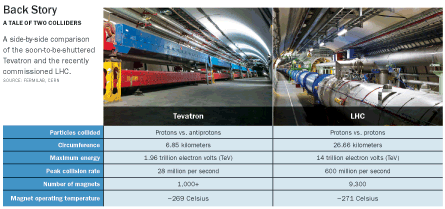The Fermi National Accelerator Laboratory’s Tevatron will shut down by the end of September, the U.S. Department of Energy has announced, dashing hopes that the 25-year-old atom smasher in Batavia, Ill., might win a transatlantic race to find the most sought-after elementary particle in high-energy physics.


Fermilab received the news from the Department of Energy on January 10 that the agency could not come up with an annual $35 million to keep the Tevatron running until 2014. The department’s advisory panel on high energy physics had recommended that the Tevatron operate for an additional three years after the European consortium CERN announced in early 2010 that its more powerful Large Hadron Collider would close down during all of 2012 for repairs. (It’s now likely that the collider will shut down in 2013 instead, a CERN official says.)
Electrical problems had already postponed by a year the opening of the Large Hadron Collider, until the fall of 2009. That delay, along with the future year-long shutdown, had seemed to give a leg up to the Tevatron in its search for the Higgs boson, a particle whose existence would explain the origin of mass in subatomic particles.
“The Tevatron has now accumulated enough data to be sensitive to the mass of the Higgs [as predicted] in the standard model” of elementary particle physics, says Stefan Söldner-Rembold, a physicist based at the University of Manchester in England who is a spokesperson for one of the Tevatron’s two main experiments. “We have reached a threshold and it seems like a waste to turn [the Tevatron] off at such a moment when one is almost there,” he notes. Over the past two years, the U.S. accelerator has narrowed the range of masses that the Higgs could have (SN: 8/14/10, p 16)
The Tevatron smashes protons into antiprotons at energies up to 1.96 trillion electron-volts, compared to the 7 TeV energy that the Large Hadron Collider now achieves in colliding twin proton beams. (By 2014, the LHC is expected to operate at its maximum energy of 14 TeV.) But it’s the intensity — the number of particles in each beam — rather than the energy that may be most important if the Higgs boson has a relatively low mass, as many physicists suspect, says Fermilab physicist Dan Green.
The Tevatron and the Large Hadron Collider now have similar beam intensities, but the Fermilab accelerator has been operating at that level for much longer, since about 2003, and has more data, Green says. The LHC, which CERN expects to triple its beam intensity in 2011, will soon catch up, he adds.
To explore other new physics, such as possible hidden dimensions or supersymmetry — the notion that every known subatomic particle has a heavier, yet-to-be-discovered counterpart — the higher energy of the Large Hadron Collider provides a huge advantage, Green says.
Because the two accelerators hunt for the Higgs in different ways — the Tevatron detects the proposed particle’s most common decay product, a bottom quark and its antiparticle, while the Large Hadron Collider records a much rarer decay mode that produces two photons — the searches are not only competitive but complementary. “It would have been very intriguing to see the Higgs” at both atom smashers and compare results, notes Söldner-Rembold.
Green adds that the lower energy of the Tevatron produces a lower background of extraneous particles, making the Higgs search there “a somewhat cleaner” process.
Because the Tevatron collides protons with antiprotons, it’s also better suited than the LHC to explore ideas about why nature contains so much more matter than antimatter (SN: 6/19/10, p. 8).
Rocky Kolb of the University of Chicago says he’s philosophical about the Tevatron’s demise. “All great accelerators have an end,” he notes. “Any disappointment at the closing of the Tevatron is tempered by my wonderful memories of my time at Fermilab, when the Tevatron was cranking out discoveries and it was the center of the high-energy physics world.”
Those highlights include the 1995 discovery of the top quark, the sixth and last discovered quark predicted to exist according to current theory. Quarks are a fundamental building block of matter.
Other Fermilab experiments won’t be affected by the shutdown. These include MINOS, in which physicists study the properties of neutrinos, which can morph from one type to another, as they journey between Fermilab and the Soudan Underground Laboratory in northern Minnesota, 724 kilometers away (SN: 7/17/10, p. 9).







